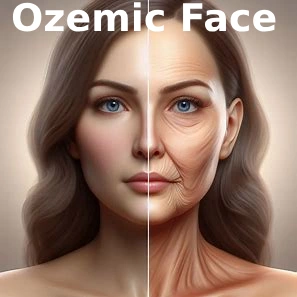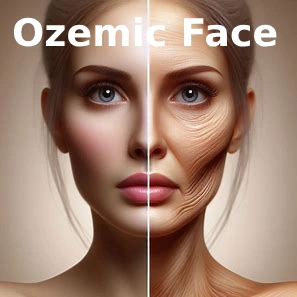Are you thrilled about your weight loss journey but noticing unexpected changes in your face? Rapid weight loss with medications like Ozempic can lead to a phenomenon now known as “Ozempic Face.” This term describes the hollow or aged look some experience as fat decreases in the face.
Did you know studies suggest that rapid fat loss often accelerates visible aging? Don’t worry—there are proven solutions to restore your glow and confidence.
What is “Ozempic Face”?
“Ozempic Face” is a term used to describe the facial changes some people notice after using the medication Ozempic, a treatment for type 2 diabetes and weight loss.
The changes are usually related to rapid weight loss, which can affect the appearance of the skin, particularly on the face. Many people experience sagging, fine lines, or a hollowed look.
Ozempic, a brand name for semaglutide, works by helping to regulate blood sugar and suppress appetite. While effective for weight loss, the reduction in fat can impact facial volume, leading to the so-called “Ozempic Face.”
Causes of Ozempic Face
1. Rapid Weight Loss
When you lose weight quickly, fat is lost not only from the body but also from the face. This loss of fat can cause the skin to sag and make the face appear aged or hollow.
2. Loss of Skin Elasticity
As we age, the skin naturally loses collagen and elastin, which help it stay firm. Rapid fat loss can make this process more noticeable, especially if the skin has already started to age.
3. Underhydration
Dehydration can make the skin look dull and highlight fine lines. People on weight loss medications sometimes don’t drink enough water, exacerbating the issue.

Signs and Symptoms of Ozempic Face
If you’re using Ozempic and notice the following changes, you might be experiencing “Ozempic Face”:
- Hollow cheeks
- Increased appearance of fine lines and wrinkles
- Loose or sagging skin
- A more aged appearance
- Dry, dull skin
While these changes might be subtle for some, others may feel it significantly impacts their self-confidence.
How to Prevent or Manage Ozempic Face
1. Gradual Weight Loss
Losing weight at a slower pace can help reduce the dramatic changes in facial appearance. Aim for 1-2 pounds per week to give your skin more time to adjust.
2. Hydration
Drinking plenty of water is essential for healthy skin. Staying hydrated can improve skin elasticity and minimize dryness.
3. A Balanced Diet
A diet rich in nutrients, especially vitamins A, C, E, and collagen-boosting foods, can help maintain healthy skin. Include foods like citrus fruits, leafy greens, nuts, and fatty fish in your meals.
4. Skin Care Routine
Using products that boost collagen production, such as retinoids or hyaluronic acid, can improve skin firmness. Regular exfoliation and moisturizing can also keep your skin looking fresh.
Popular Treatments for Rejuvenating Facial Appearance
If lifestyle changes are not enough, cosmetic treatments can help restore volume and tighten skin. Here are some popular options:
1. Dermal Fillers
Fillers like hyaluronic acid can restore lost volume and smooth out wrinkles. They are a quick, non-invasive option with immediate results.
Visit our Website for more information.
2. Botox
Botox can relax wrinkles and fine lines, making the face look smoother and younger. It’s often used in combination with fillers.
3. Laser Skin Treatments
Laser therapy can stimulate collagen production, helping to tighten skin and improve texture. This option works well for people with mild to moderate sagging.
4. Microneedling
This procedure creates tiny injuries in the skin to boost collagen production. It’s effective for improving skin texture and elasticity.
5. Facelift Surgery
For those with severe sagging, a facelift may be an option. This is a surgical procedure that provides long-lasting results by removing excess skin and tightening underlying tissues.
Tip: Always consult a board-certified dermatologist or plastic surgeon before undergoing any cosmetic procedure.
Expert Opinions on Ozempic Face
Dermatologists and plastic surgeons agree that the changes associated with “Ozempic Face” are primarily due to rapid fat loss rather than the medication itself. Dr. Jane Simmons, a board-certified dermatologist, explains, “Maintaining healthy skin during weight loss requires a combination of hydration, proper nutrition, and sometimes cosmetic interventions.”

FAQs About Ozempic Face
1. Can Ozempic itself cause skin changes?
No, the medication doesn’t directly cause skin changes. The changes are a result of the fat loss associated with using Ozempic.
2. Is Ozempic Face permanent?
No, it’s not permanent. With proper care, lifestyle changes, and cosmetic treatments, the appearance of Ozempic Face can be improved.
3. How long does it take for skin to adjust after weight loss?
It varies depending on factors like age, genetics, and the amount of weight lost. Skin can take several months to years to fully adjust.
4. Can skincare products alone fix Ozempic Face?
While skincare can help improve the texture and elasticity of the skin, it may not fully restore lost volume. Combining skincare with cosmetic treatments often yields better results.
5. Should I stop using Ozempic if I notice Ozempic Face?
Consult your doctor before making any changes to your medication. There are ways to manage the side effects without discontinuing treatment.
Final Words
“Ozempic Face” is a common concern for individuals experiencing rapid weight loss with the help of Ozempic. While the facial changes can be concerning, they’re manageable with proper skincare, a balanced diet, hydration, and, if necessary, cosmetic procedures.
Remember, achieving your health goals is the priority, and there are solutions to help you look and feel your best along the way.
If you’re worried about the effects of weight loss on your appearance, consult a healthcare professional or dermatologist for personalized advice.


